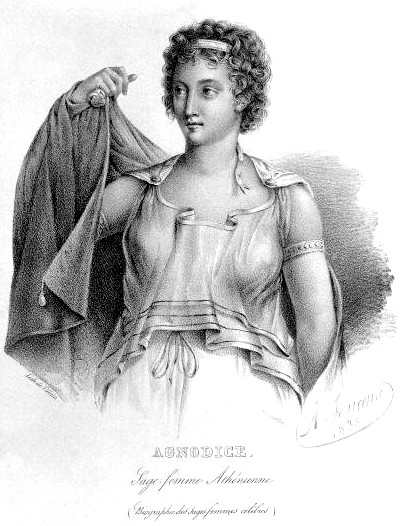
Agnodice received her medical education in Alexandria, Egypt at the University of Alexandria, and studied under Herophilos, the great anatomist of his day. Soon after acquiring the requisite qualifications, she continued to dress as a man in order to treat the women of Athens. One day, Agnodice heard a woman crying out as she was undergoing labor. Agnodice then went to care for the women in labor, but the woman refused male aid. After revealing herself as a woman, the woman allowed Agnodice to treat her successfully. During the time, women dreaded calling in professional assistance. Agnodice symbolized the trust and comfort between women aiding women. Before long, many women heard about Agnodice being disguised as a male and sought for her care. Agnodice popularity grew the women from the city of Athens began to seek her aid rather than male physicians.
When male physicians began to see that their services were no longer desired by women, the male physicians began to accuse Agnodice for seducing the women and the women were accused of feigning illnesses. Agnodice was then tried before a group of jealous husbands and rivaled doctors for seducing the women of Athens. When Agnodice was brought before the court assembled on a hill near Athens called Areopagus, the men began to condemn her. She then lifted her tunic to revealed her true identity and was condemned further by the men of Athens for her deceit and false pretenses. With a crime warranted of execution if carried out, Agnodice then convinced the judges that it was impossible she could be guilty of the alleged crimes the men claimed upon her. Her adversaries then sought to condemn her for violating the law in which women were not allowed to study any branch of medicine. Before the judges ruled on the trial, a crowd of women arrived at her trial to praise her successes as a physician and chastised their husbands for trying to execute Agnodice. After a short debate, Agnodice was acquitted from her charges and the Athenian law was changed to allow women to be treated by female physicians in Athens.
Before Agnodice, women were taking care of the sick, as well as trying to figure out how the body worked and causes of diseases. Women were also midwives, helping deliver babies, but were not allowed to practice medicine. For the Greeks, Agnodice trial brought changes with the Athenians law which thereby allowed women to study medicine. Agnodice story has also been used through the seventeenth century as a tale for midwives to defend themselves against male-dominated professions seeking to incorporate the study of medicine into childbirth.
No comments:
Post a Comment